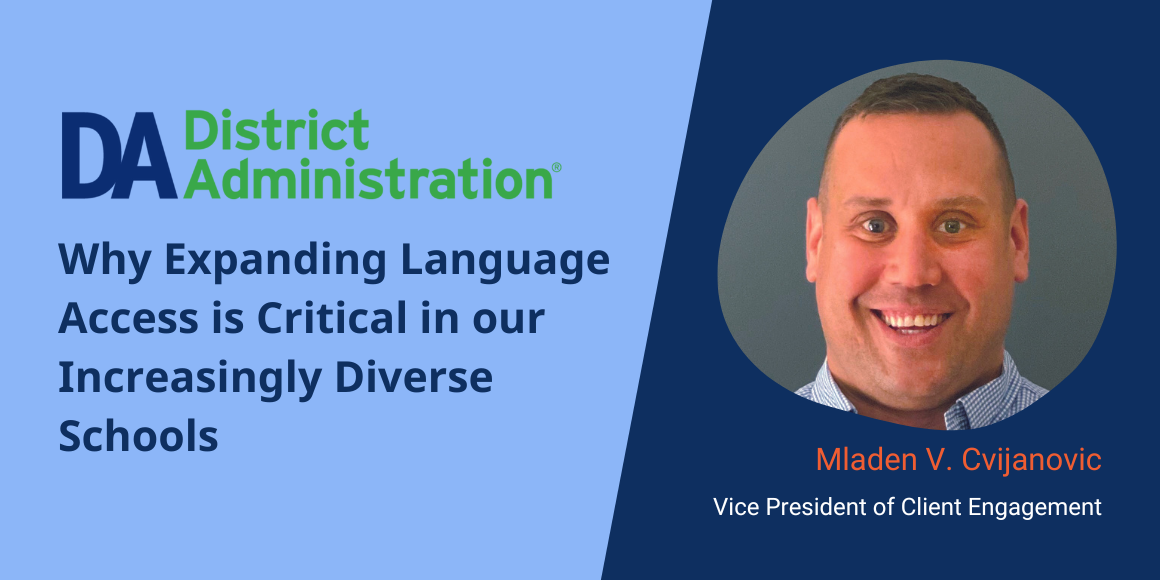Original publication: District Administration
It's not uncommon for some districts to serve students and families from 50 or more language backgrounds.
Communities across the country are becoming increasingly diverse, which means their neighborhood schools are too. One of the side effects of this diversity is an increased number of multilingual or non-native English-speaking students.
School districts want to deliver equal access to education for all of their students, including those from diverse linguistic backgrounds. However, many districts have hit a roadblock: They’re unsure of how to implement robust language access in a way that’s most effective for students and their families.
By contracting with a reputable language solutions partner, school districts can meet the needs of students and their families in a way that’s both accommodating and efficient. In doing so, school districts can:
- Quickly disseminate emergency information and other announcements to the entire multilingual school district and their families
- Build a bridge between students and classroom teachers to improve candor and academic opportunities, all while nurturing the mental, emotional, and intellectual well-being of their students
- Increase the involvement of parents and caregivers from multilingual backgrounds
- Address discipline and safety concerns in a clear, professional manner
Barriers to comprehensive language access
Too often, K-12 school districts operate in silos. As a result, rural schools may lack adequate language access, and after-school and extracurricular activities may forgo language support altogether. Students with limited English proficiency who do not receive proper accommodations fall further and further behind academically. In order to serve all students equally, school districts must roll out language access procurement plans that scale efficiently by pooling resources together at the regional and state levels.
Out of desperation, school districts may adopt service-based language access, without thinking through the long-term outcomes for their multilingual students. Unfortunately, the result is piecemeal, selective, and expensive.
It’s not uncommon for some districts to serve students and families from 50 or more language backgrounds. Non-scaled language partners can provide quality solutions but fail to meet the full range of demographics they serve.
Compliance is another concern. Districts must comply with state and federal regulations without the services becoming too costly. Budget restraints can cause districts to pare down their language offerings. In the long run, these band-aid solutions can be quite costly when it comes to student success and parent engagement.
Then there are the cultural implications of language access. Language solutions act as a cultural liaison and provide cultural competency, especially around sensitive or emotionally charged situations. For example, in the case of disciplinary or academic concerns, a third-party interpreter who joins the dialogue between students, parents, and school faculty can defuse tension and offer clarity and understanding.
Achieving long-term success
Districts of all sizes can take steps today to improve translation and interpretation services in order to overcome language barriers and support the full range of their multilingual populations. These steps include:
- Centralizing language accessibility: By employing a single LSP across the district or state, schools can join forces to offer scalable, consistent, and comprehensive solutions for their students.
- Deploying comprehensive language access: Language support solutions–including over-the-phone interpretation, video remote interpretation, and remote simultaneous interpretation–must be holistic and their availability clearly communicated to students and their families.
- Demonstrating cultural competency: Districts can build bridges with families by demonstrating cultural competency and community-building. ULG, for example, disseminated multilingual, pro-bono literature to families during the COVID-19 pandemic to share critical resources and information.
- Scaling for the future: Districts must consider both the quality and quantity of the language solutions they offer so that language support keeps pace as their district demographics shift.
School districts must work to nurture every aspect of a student’s academic and personal growth. For multilingual students, that begins with language support. By partnering with the right provider, school districts can deliver efficient, economic, and effective language access solutions to meet the holistic needs of your students and their families for long-term personal and academic success.
Mladen V. Cvijanovic is the vice president of client engagement at United Language Group.

